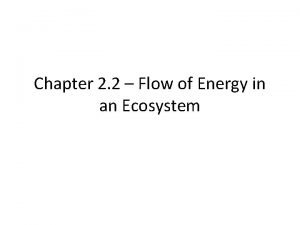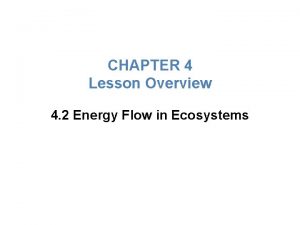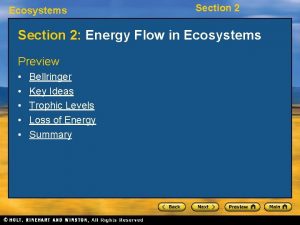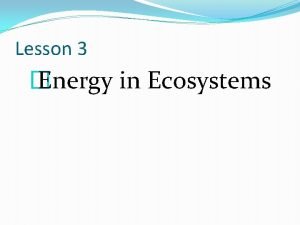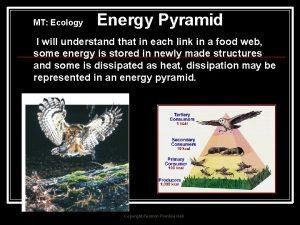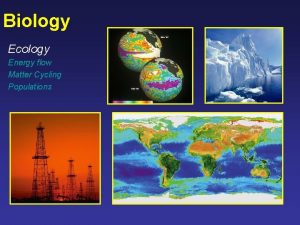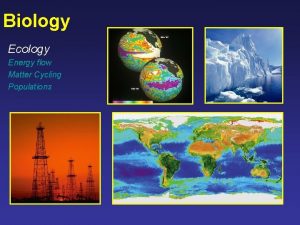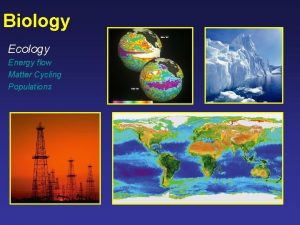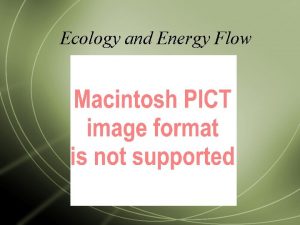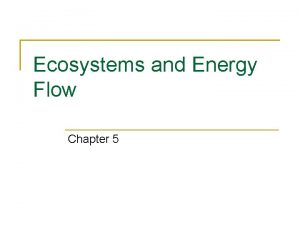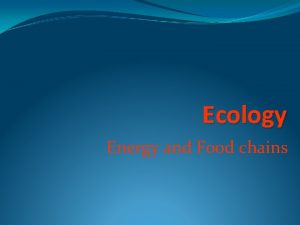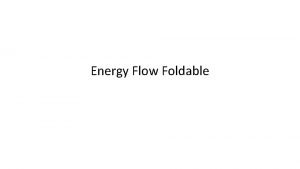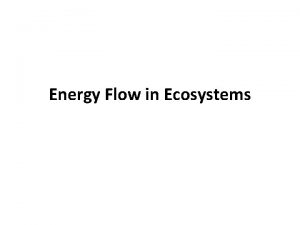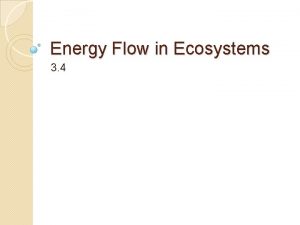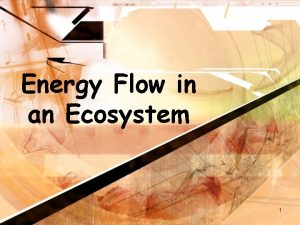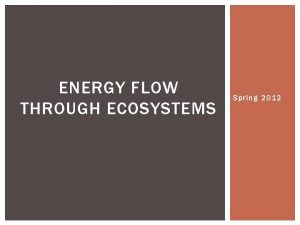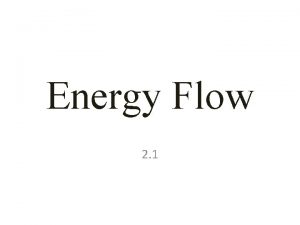Chapter 3 Ecology Energy Flow Ecology is the
































- Slides: 32

Chapter 3 Ecology Energy Flow

• Ecology is the study of the way living things interact with each other and their physical environment.

How does energy flow? • Energy flows in one direction. From sun to the producers to the consumers • Producers (plants)= organisms that make their own food to obtain energy • Consumers( animals)= organisms that consume other organism for energy • Heat Energy (sun) is converted to Chemical Energy (food) through energy flow. • Some energy is lost to heat at each transfer

Producers Organisms that use energy from the environment (make their own food) through sunlight or chemicals are called autotrophs or PRODUCERS.

• The main source of energy for life on Earth is the SUN.

• Organisms use sunlight through photosynthesis.

• Photosynthesis is the use of light energy to power chemical reactions that convert carbon dioxide and water into oxygen and carbohydrates like sugar and starch.


• On land, plants are the main autotroph. In freshwater ecosystems and the sunlit upper layers of the ocean, algae are the principal autotrophs.

Cyanobacteria • Photosynthetic bacteria are the most common and produce much of the earth’s oxygen.

• Some autotrophs rely on stored energy found in inorganic chemical compounds instead of the sun. • Since they get their energy from chemicals, they are called chemotrophs and use chemosynthesis to produce carbohydrates.

• Chemosynthesis is performed by several types of bacteria. These bacteria can be found in obscure places like:

• Volcanic vents on the ocean floor.

Hot Springs & Tidal Marshes along the coast.

• Organisms that cannot harness energy directly must acquire energy from other organisms and are called consumers or heterotrophs. • There are many different kinds of heterotrophs:

Herbivores only eat plants.

Prey Carnivores only eat meat Predator

Omnivores eat plants & meat

Detritivores • Mites, earthworms, snails, and crabs feed on plant and animal remains and other dead matter, called detritus.

Decomposers (Saprophytes) break down organic matter.

What are some ways we can see how energy is transferred? • • • Ecological Food Chains and Webs Ecological Pyramids Energy Pyramids Biomass Pyramids Numbers Pyramids

• Energy flows through an ecosystem in one direction, from the sun or inorganic compounds to autotrophs (producers) and then to various heterotrophs (consumers).

Food Chain • Series of steps in which organisms transfer energy by eating and being eaten.

Food Chain What are the producers in this chain? What are the secondary consumers? Where is the least energy in this chain? What type of feeding organism is the squid?

• Food Webs are the feeding relationships among the different organisms in an ecosystem. • Each step in a food chain or food web is a trophic level.


Food Chains and Webs • Producers are at the beginning(photosynthetic organisms) • Herbivores (primary consumersget energy only from plants (grasshopper) • Carnivores (secondary/tertiary consumers-feed on other animals (owl) • Omnivore= organism that feeds on both plants and animals • ARROWS INDICATE THE TRANSFER OF ENERGY • The most of the energy is at the producer level. Least is at the top level • Trophic Levels: each step in a food chain or web

Ecological Pyramids • A diagram that shows the relative amounts of energy or matter contained within each trophic level in a food chain or food web. • Only 10% of the energy available within one trophic level is transferred to organisms at the next trophic level.

Ecological Pyramid

Energy Pyramid • shows the relative amount of energy at each trophic level • Average energy transfer form one trophic level to the next is 10% Biomass Pyramid of Numbers • Shows the total amount of living tissue within trophic level • Shows the relative number of organisms at each trophic level • Highest quantity on the bottom lowest on the top

Biomass • The total amount of living tissue within a given trophic level. • A biomass pyramid represents the amount of potential food available for each trophic level in an ecosystem.

 Section 1 organisms and their relationships
Section 1 organisms and their relationships Principles of ecology section 2 flow of energy
Principles of ecology section 2 flow of energy Principles of ecology 2 flow of energy in an ecosystem
Principles of ecology 2 flow of energy in an ecosystem Flow energy review
Flow energy review Oikos meaning
Oikos meaning Energy energy transfer and general energy analysis
Energy energy transfer and general energy analysis Energy energy transfer and general energy analysis
Energy energy transfer and general energy analysis Section 1 population dynamics answer key
Section 1 population dynamics answer key Chapter 4 lesson 2 energy flow in ecosystems
Chapter 4 lesson 2 energy flow in ecosystems Chapter 2 section 2 flow of energy in an ecosystem
Chapter 2 section 2 flow of energy in an ecosystem Energy in ecosystems lesson 3 answer key
Energy in ecosystems lesson 3 answer key Energy pyramid definition ecology
Energy pyramid definition ecology Chapter 7 energy conservation of energy
Chapter 7 energy conservation of energy Hát kết hợp bộ gõ cơ thể
Hát kết hợp bộ gõ cơ thể Slidetodoc
Slidetodoc Bổ thể
Bổ thể Tỉ lệ cơ thể trẻ em
Tỉ lệ cơ thể trẻ em Gấu đi như thế nào
Gấu đi như thế nào Tư thế worm breton là gì
Tư thế worm breton là gì Chúa yêu trần thế alleluia
Chúa yêu trần thế alleluia Môn thể thao bắt đầu bằng từ đua
Môn thể thao bắt đầu bằng từ đua Thế nào là hệ số cao nhất
Thế nào là hệ số cao nhất Các châu lục và đại dương trên thế giới
Các châu lục và đại dương trên thế giới Công thức tính thế năng
Công thức tính thế năng Trời xanh đây là của chúng ta thể thơ
Trời xanh đây là của chúng ta thể thơ Mật thư tọa độ 5x5
Mật thư tọa độ 5x5 Làm thế nào để 102-1=99
Làm thế nào để 102-1=99 độ dài liên kết
độ dài liên kết Các châu lục và đại dương trên thế giới
Các châu lục và đại dương trên thế giới Thơ thất ngôn tứ tuyệt đường luật
Thơ thất ngôn tứ tuyệt đường luật Quá trình desamine hóa có thể tạo ra
Quá trình desamine hóa có thể tạo ra Một số thể thơ truyền thống
Một số thể thơ truyền thống Cái miệng nó xinh thế
Cái miệng nó xinh thế


